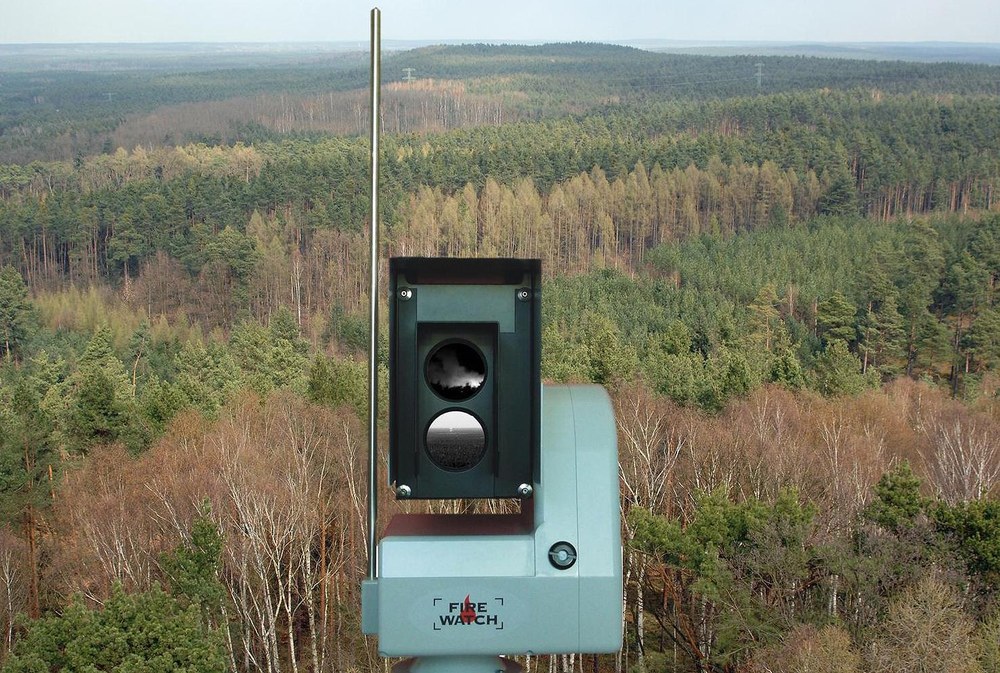Space cameras as early warning systems for forest fires

At 13:28 CEST on 2 July 2015, the alarm in the Wünsdorf forest fire centre went off. Smoke had been seen rising from the forest district in Baruth. The German Meteorological Service had previously raised the risk of forest fire to the highest alert level. In the past, employees of the Brandenburg state forestry office sat in the cramped towers – 100 steps above the ground – using binoculars as they scanned the horizon for signs of forest fires during the hot summer months. To complement this task today, five federal states in Germany have installed 180 cameras that were originally designed for use in space. "The German Aerospace Center (Deutsches Zentrum für Luft- und Raumfahrt; DLR) developed the FireWatch camera technology 20 years ago. The system is based on technology found in the ROLIS camera on the Philae lander, which recently acquired spectacular images of Comet 67P/Churyumov-Gerasimenko," explains Ekkehard Kührt, a comet researcher at DLR and a scientist working in the European Rosetta mission. He is also responsible for the prize-winning technology transfer project FireWatch.
In recent years, a small DLR team at the Institute of Planetary Research – supported by DLR Technology Marketing – has been cooperating with Berlin-based industrial partner IQ wireless GmbH to take the development of FireWatch to the next level, tailoring it to meet the needs of the market. DLR also relied on the expertise acquired from space missions to develop the software that analyses the observed greyscales. "In space, we analyse comet dust; here on Earth we do the same with smoke clouds," says Kührt. The forest fire early warning system does not respond to heat or flames; instead, it looks for signs of smoke, offering far greater precision than the human eye.
Sensors instead of eyes
"It used to be so hot that staff keeping watch on the towers would experience temperatures that made them feel as though they were being roasted," reminisces Raimund Engel, a forest fire prevention officer at the Brandenburg state forestry office. Back then, the towers would be staffed from 10:00 to 21:00 to report even the smallest hint of a forest fire as early as possible. At night, at these latitudes, humidity ensures that fires are almost unheard of, but the forestry staff had to watch over the woods during the day. "Optical sensors are far superior to the human eye – they never get tired and can detect signs of smoke much earlier and with greater precision," Engel says.
Each camera turns on its axis once every six minutes, sweeping its gaze over up to 700 square kilometres. The cameras are able to distinguish barely detectable smoke clouds from the 16,000 greyscales picked up from an environment full of trees, cities, towns, lakes and fields. As soon as the camera spots what may be smoke, it acquires images and sends them to the forest fire centres, where the coordinates of the fire are automatically determined and shown on a map. Detecting forest fires is difficult, as the system must provide sufficiently early notice while still ensuring that false alarms remain as infrequent as possible. Ultimately, the forestry officials use the data transmitted by FireWatch to decide whether a forest fire has been detected and determine the number of crews that should be deployed to control it.
Coming down to Earth
Use of this space technology first began during the 1990s, when Kührt read an article in a regional newspaper describing the problems encountered by forestry offices with human forest fire monitoring from high towers. Work on the small DLR BIRD satellites used to spot forest fires from space was already in progress, as was the development of the ROLIS camera for the Philae lander. The DLR Institute of Planetary Research was more than happy to offer its assistance, as it already possessed substantial knowledge of forest fires and cameras. The initial pilot project, which took place in the Peitz forestry office in Brandenburg in 1999, used three cameras. The firm IQ wireless GmbH took over series production and marketing of the FireWatch system in 2001. Since then, additional cameras have been installed every year. "FireWatch cameras are now fitted across Germany in areas with an elevated risk of forest fires," says Managing Director Holger Vogel. "Nowadays, FireWatch is even being used abroad – for instance in Kazakhstan, the United States, the Baltic states and in Mexico." In these countries, however, the cameras and analysis software encounter different landscape structures and environmental conditions. For instance, systems to spot forest fires must also operate at night in southern Europe or in Australia.
"FireWatch is now a mature product and has proven its worth," emphasises Kührt. There are more than 1000 fires per year in German forests alone. When the alarm went off in the forestry office in Baruth on 2 July 2015, forest fire prevention officer Engel quickly realised that something major was occurring. He immediately deployed a large crew to the site, and the fire was put out effectively thanks to the FireWatch early warning system. This was just one of over 160 forest fires registered in Brandenburg so far this year.


